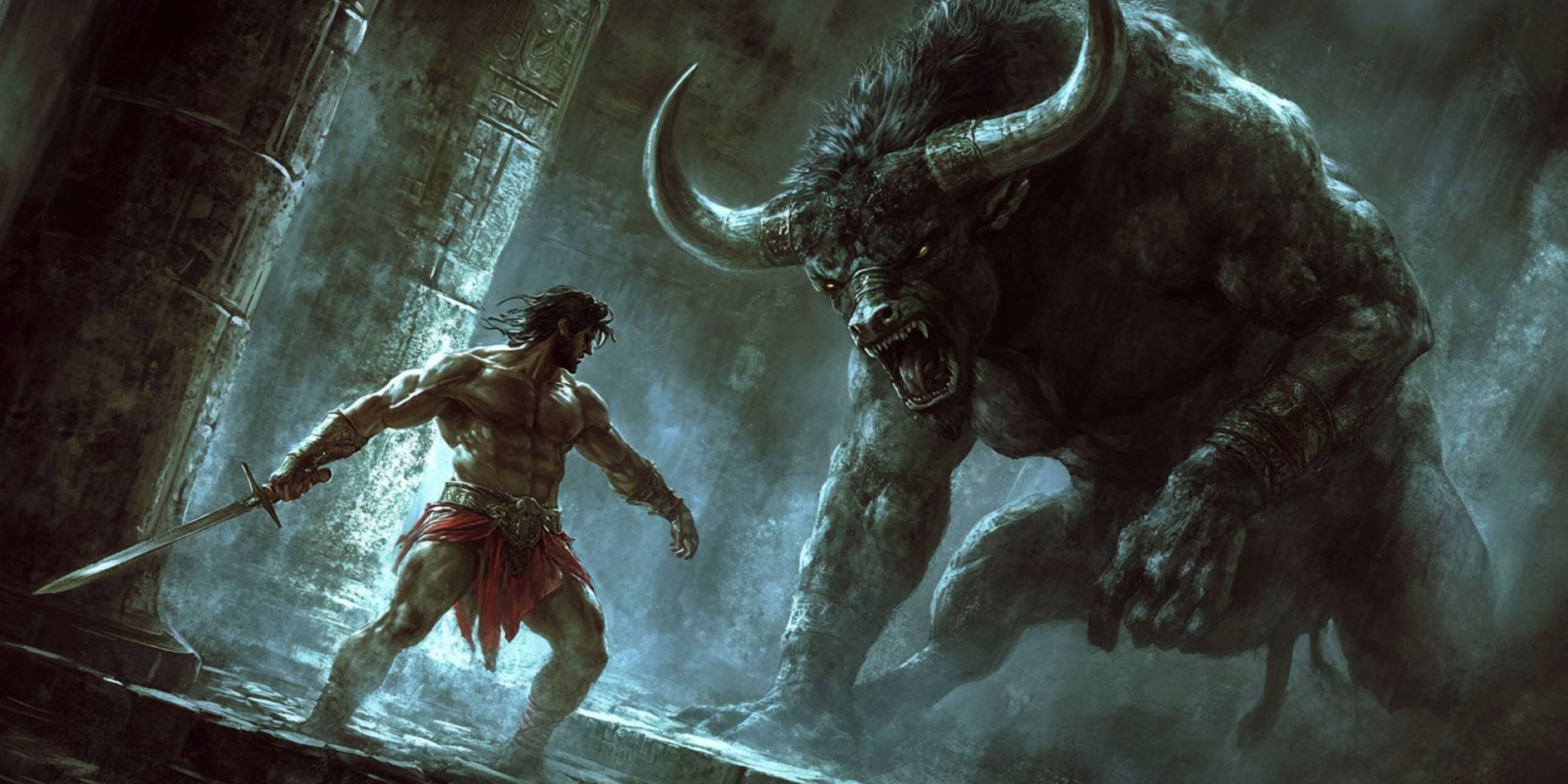
Ever wondered about the legendary creature known as the Minotaur? This mythical beast, with the body of a man and the head of a bull, has fascinated people for centuries. Originating from ancient Greek mythology, the Minotaur was said to dwell in the labyrinth of Crete, a maze so complex that escape was nearly impossible. But who created this fearsome creature, and why? King Minos of Crete ordered the construction of the labyrinth to imprison the Minotaur, born from a union between his wife, Pasiphaë, and a divine bull. What happened to the Minotaur? The hero Theseus eventually defeated it, ending its reign of terror. Dive into these 37 intriguing facts to learn more about the Minotaur's origins, symbolism, and lasting impact on culture.
Key Takeaways:
- The Minotaur, a creature from Greek mythology, was born from the union of Pasiphaë and a majestic bull sent by the god Poseidon. It was kept in a labyrinth by King Minos to hide it from the public.
- The Minotaur represents the duality of human nature and has influenced various forms of art and literature. It continues to captivate people's imaginations and has found its way into modern culture.
The Origin of the Minotaur
The Minotaur, a creature from Greek mythology, has fascinated people for centuries. Let's dive into some intriguing facts about this legendary beast.
-
The Minotaur's name means "Bull of Minos." It combines "Minos," the name of the Cretan king, and "Taurus," the Latin word for bull.
-
According to myth, the Minotaur was born from the union of Pasiphaë, the wife of King Minos, and a majestic bull sent by the god Poseidon.
-
King Minos kept the Minotaur in a labyrinth, a complex maze designed by the architect Daedalus, to hide the creature from the public.
-
The labyrinth was so intricate that even Daedalus himself had trouble navigating it after its completion.
The Minotaur's Role in Mythology
The Minotaur played a significant role in various myths and stories. Here are some key points about its place in Greek mythology.
-
The Minotaur was fed with human sacrifices, specifically young men and women from Athens, as a form of tribute to King Minos.
-
Theseus, a hero from Athens, volunteered to be one of the sacrifices with the intention of killing the Minotaur and ending the tributes.
-
Ariadne, King Minos' daughter, fell in love with Theseus and gave him a ball of thread to help him navigate the labyrinth and find his way back after killing the Minotaur.
-
Theseus successfully killed the Minotaur using a sword given to him by Ariadne and followed the thread back to safety.
Symbolism and Cultural Impact
The Minotaur has been a powerful symbol in various cultures and has influenced many forms of art and literature.
-
The Minotaur represents the duality of human nature, combining both human intelligence and animalistic instincts.
-
In modern times, the Minotaur has appeared in various books, movies, and video games, often symbolizing inner demons or challenges to be overcome.
-
The story of the Minotaur and the labyrinth has inspired numerous works of art, including paintings, sculptures, and even operas.
-
The Minotaur is often depicted as a fearsome creature with the body of a man and the head of a bull, emphasizing its hybrid nature.
The Labyrinth: A Maze of Mystery
The labyrinth where the Minotaur was kept is almost as famous as the creature itself. Let's explore some facts about this legendary maze.
-
The labyrinth was located on the island of Crete, near the palace of Knossos, which was the center of Minoan civilization.
-
Some historians believe the labyrinth was inspired by the complex layout of the palace itself, which had numerous rooms and corridors.
-
The term "labyrinth" has come to symbolize any complex or confusing situation, thanks to the myth of the Minotaur.
-
Archaeologists have found evidence of intricate mazes in other ancient cultures, suggesting that the concept of a labyrinth was widespread.
The Minotaur in Modern Culture
The Minotaur continues to captivate people's imaginations and has found its way into various aspects of modern culture.
-
In literature, the Minotaur has appeared in works by authors like Jorge Luis Borges and Rick Riordan, each offering a unique take on the myth.
-
Movies such as "Immortals" and "Percy Jackson & the Olympians" feature the Minotaur as a formidable adversary.
-
The Minotaur has also made appearances in video games like "God of War" and "Assassin's Creed Odyssey," where players can battle the creature.
-
In comic books, the Minotaur has been portrayed as both a villain and a tragic figure, reflecting its complex nature.
The Minotaur's Legacy
The legacy of the Minotaur extends beyond mythology and into various fields of study and popular culture.
-
Psychologists have used the Minotaur as a metaphor for the subconscious mind and the inner struggles people face.
-
The Minotaur has been a subject of academic study, with scholars analyzing its role in Greek mythology and its impact on later cultures.
-
In astrology, the Minotaur is sometimes associated with the zodiac sign Taurus, which represents strength and determination.
-
The Minotaur has inspired numerous adaptations in theater, including plays and ballets that reinterpret the myth for modern audiences.
Fun Facts About the Minotaur
Here are some lighter, fun facts about the Minotaur that you might not know.
-
The Minotaur's diet in mythology was said to consist mainly of human flesh, making it one of the most fearsome creatures in Greek lore.
-
Some versions of the myth suggest that the Minotaur had a tragic side, being a victim of circumstances beyond its control.
-
The Minotaur's roar was said to be so powerful that it could shake the walls of the labyrinth.
-
In some artistic depictions, the Minotaur is shown with a more human-like face, emphasizing its dual nature.
The Minotaur in Art and Literature
The Minotaur has been a popular subject in various forms of art and literature throughout history.
-
Picasso created a series of artworks featuring the Minotaur, exploring themes of power and vulnerability.
-
The Minotaur appears in Dante's "Inferno," where it guards the entrance to the seventh circle of Hell.
-
In the novel "House of Leaves" by Mark Z. Danielewski, the labyrinth and the Minotaur are central symbols representing fear and the unknown.
-
The Minotaur has been featured in numerous poems, including works by poets like Ted Hughes and Sylvia Plath.
The Minotaur's Influence on Modern Media
The Minotaur's influence extends to various forms of modern media, from television to video games.
-
The TV series "Doctor Who" featured an episode with a creature inspired by the Minotaur, trapped in a maze-like spaceship.
-
In the "Harry Potter" series, the Triwizard Tournament's maze is reminiscent of the labyrinth, with dangerous creatures lurking within.
-
The Minotaur has been a popular character in role-playing games like "Dungeons & Dragons," where it often serves as a formidable foe.
-
In the world of anime, the Minotaur has appeared in series like "Fate/Grand Order" and "DanMachi," showcasing its enduring appeal.
-
The Minotaur's story has been adapted into various graphic novels, each offering a unique interpretation of the myth.
The Minotaur's Legacy
The Minotaur remains one of mythology's most intriguing figures. This half-man, half-bull creature has fascinated people for centuries. Its story, rooted in Greek mythology, tells of a beast trapped in a labyrinth, symbolizing complex human emotions and struggles. The Minotaur's tale isn't just about a monster; it's about human nature, choices, and consequences.
From ancient texts to modern adaptations, the Minotaur's influence is undeniable. It appears in literature, movies, and even video games, showing its lasting impact on culture. Understanding the Minotaur helps us appreciate the depth of mythological stories and their relevance today.
So, next time you encounter a reference to the Minotaur, remember its rich history and the lessons it carries. This mythical creature isn't just a relic of the past; it's a symbol of enduring human themes and the power of storytelling.
Frequently Asked Questions
Was this page helpful?
Our commitment to delivering trustworthy and engaging content is at the heart of what we do. Each fact on our site is contributed by real users like you, bringing a wealth of diverse insights and information. To ensure the highest standards of accuracy and reliability, our dedicated editors meticulously review each submission. This process guarantees that the facts we share are not only fascinating but also credible. Trust in our commitment to quality and authenticity as you explore and learn with us.


